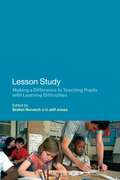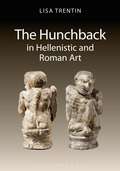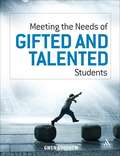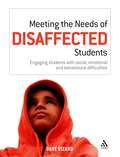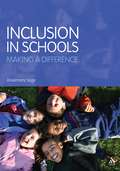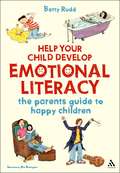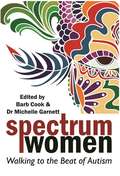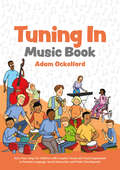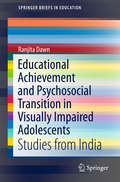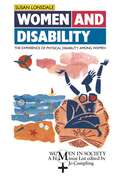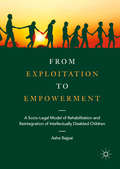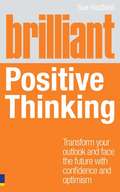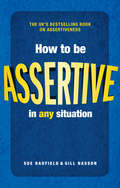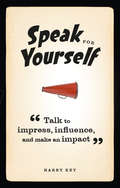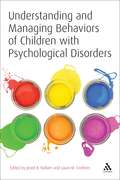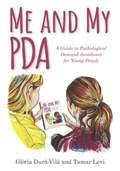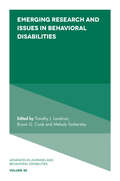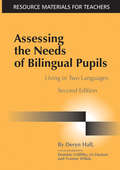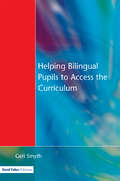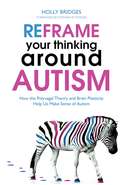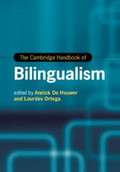- Table View
- List View
Lesson Study: Making a Difference to Teaching Pupils with Learning Difficulties
by Brahm Norwich Jeff JonesLesson Study has been developed and used in Japan for over a century and is increasingly used in the Far East, USA and now in Europe. Lesson Study shows how this powerful model of professional learning has been integrated with the principles of inclusive practice by classroom teachers in the challenging area of teaching pupils in the spectrum from Moderate Learning Difficulties (MLD) to low attainment. The book illustrates how Lesson Study has been practised and explores the optimal conditions in schools for its effective use.Essential reading for trainee and practicing teachers with an interest in how professional practice can enhance reflective practice as a means of school improvement and innovation for all pupils.
The Hunchback in Hellenistic and Roman Art
by Lisa TrentinThe subject of deformity and disability in the ancient Greco-Roman world has experienced a surge in scholarship over the past two decades. Recognizing a vast, but relatively un(der)explored, corpus of evidence, scholars have sought to integrate the deformed and disabled body back into our understanding of ancient society and culture, art and representation. The Hunchback in Hellenistic and Roman Art works towards this end, using the figure of the hunchback to re-think and re-read images of the 'Other' as well as key issues that lie at the very heart of ancient representation. The author takes an art-historical approach, examining key features of the corpus of hunchbacks, as well as representations of the deformed and disabled more generally. This provides fertile ground for a re-assessment of current, and likewise marginalized, scholarship on the miniature in ancient art, hyperphallicism in ancient art, and the emphasis on the male body in ancient art.
Meeting the Needs of Gifted and Talented Students (Meeting the Needs)
by Gwen GoodhewThis introductory guide for class teachers in primary and secondary schools looks at current strategies for identifying able, gifted and talented children and meeting their social, emotional and educational needs. Illustrated throughout with case studies and FAQs, the book will also be of interest to PGCE students, G&T coordinators and those undergoing training as leading teachers.
Meeting the Needs of Disaffected Students: Engaging students with social, emotional and behavioural difficulties (Meeting the Needs)
by Dave VizardThrough the use of a variety of approaches and techniques, including emotional literacy, NLP and learning styles, this resource gives practical examples of how to engage disaffected students and ensure they have a successful learning experience.The book outlines the causes of disaffection generally and looks at a range of syndromes and conditions that may give rise to disaffection, offering support strategies that will encourage the engagement of such students. The book also outlines approaches for helping students to self-manage their behaviour and learning.
Inclusion in Schools: Making a Difference
by Rosemary SageBy 1987 Swaggart was one of the most popular video preachers in the world, with a weekly television audience of 2.1 million in the US and a worldwide audience of millions more in 143 countries. But then, in a cheerless motel west of New Orleans, Jimmy's life and ministry took a calamitous turn. This the tale of the rise of two intimately linked colossi of the American century: Pentecostalism, the fastest growing religious movement in the world, and its "evil twin", Rock 'n' Roll. A major theme of the book is how the religious ecstasy of Pentecostalism - the rousing music, the speaking in tongues, the reception of the Spirit - combined with its severe sexual repression leads to the kind of furtive acting out that brought down not only Jimmy Swaggart but also other evangelists. It is the story, too, of the rapid rise of the Religious Right, with its competing personalities and ideologies. In the end, the author sees Jimmy as a victim - like many others - of a primitive faith colliding with the forces of the late 20th century fame.
Help Your Child Develop Emotional Literacy: The parents' guide to happy children (Help Your Child to Succeed)
by Betty RuddThis book focuses on developing important qualities such as emotional awareness, confidence and self-motivation. It outlines simple steps to teach your child how to manage their feelings, behave appropriately and learn from their experiences. Packed full of tips, examples and fun activities, this easy-to-follow guide will give you the tools and confidence to nurture your child's emotional and mental wellbeing right from the start. Perfect for parents and carers, this book will also be a source of inspiration to teachers, teaching assistants, counsellors, psychotherapists and anyone wanting to boost a child's emotional wellbeing. Packed full of tips, examples and fun activities, this easy-to-follow guide will give you the tools and confidence to nurture your child's emotional and mental wellbeing right from the start. Perfect for parents and carers, this book will also be a source of inspiration to teachers, teaching assistants, counsellors, psychotherapists and anyone wanting to boost a child's emotional wellbeing.
Spectrum Women: Walking to the Beat of Autism
by Barb Cook Michelle Garnett Jen Elcheson Artemisia Catriona Stewart Anita Lesko Liane Holliday Willey Samantha Craft Jeanette Purkis Kate Ross Becca Lory Renata Jurkevythz Terri Mayne Maura Campbell Dena Gassner Lisa Morgan Christine JenkinsBarb Cook and 14 other autistic women describe life from a female autistic perspective, and present empowering, helpful and supportive insights from their personal experience for fellow autistic women. Michelle Garnett's comments validate and expand the experiences described from a clinician's perspective, and provide extensive recommendations.Autistic advocates including Liane Holliday Willey, Anita Lesko, Jeanette Purkis, Artemisia and Samantha Craft offer their personal guidance on significant issues that particularly affect women, as well as those that are more general to autism. Contributors cover issues including growing up, identity, diversity, parenting, independence and self-care amongst many others. With great contributions from exceptional women, this is a truly well-rounded collection of knowledge and sage advice for any woman with autism.
Spectrum Women: Walking to the Beat of Autism
by Barb Cook Michelle Garnett Jen Elcheson Artemisia Catriona Stewart Anita Lesko Liane Holliday Willey Samantha Craft Jeanette Purkis Kate Ross Becca Lory Renata Jurkevythz Terri Mayne Maura Campbell Dena Gassner Lisa Morgan Christine JenkinsBarb Cook and 14 other autistic women describe life from a female autistic perspective, and present empowering, helpful and supportive insights from their personal experience for fellow autistic women. Michelle Garnett's comments validate and expand the experiences described from a clinician's perspective, and provide extensive recommendations.Autistic advocates including Liane Holliday Willey, Anita Lesko, Jeanette Purkis, Artemisia and Samantha Craft offer their personal guidance on significant issues that particularly affect women, as well as those that are more general to autism. Contributors cover issues including growing up, identity, diversity, parenting, independence and self-care amongst many others. With great contributions from exceptional women, this is a truly well-rounded collection of knowledge and sage advice for any woman with autism.
Tuning In Music Book: Sixty-Four Songs for Children with Complex Needs and Visual Impairment to Promote Language, Social Interaction and Wider Development
by Adam OckelfordContaining 64 songs designed to promote language, social and musical development, this book accompanies the Tuning In Cards so you can perform the songs and integrate the activities into your own practice. When paired with the Tuning In Cards, it will offer an innovative way of developing communication in children with profound disabilities, visual impairment, and autism.These songs have been developed in line with the Sounds of Intent framework and in collaboration with The Amber Trust. A helpful introduction by the composer describes how to adapt the songs and activities to the appropriate developmental level.
Educational Achievement and Psychosocial Transition in Visually Impaired Adolescents: Studies from India (SpringerBriefs in Education)
by Ranjita DawnThis book provides a fresh approach to studies on adolescents with visual impairment. It threads through the three elements of disability (visual impairment), psychosocial development of adolescents, and their educational achievement. It highlights how these concepts traverse across and cast an irrefutable impact on each other. The author prepares the ground by highlighting the failure of existing theories of disability studies in addressing issues concerning adolescents. She further critiques the psycho-medical approach to disability which undermines or disregards its social construction. The book provides an analysis of numerous issues affecting the psychosocial development of adolescents with visual impairment, which is further validated through narratives in educational settings. It also strongly advocates the need to create awareness about the basic ethics of human relationships and rights, moral consciousness and social and civic responsibilities, which can play a vital role in ensuring healthy psychosocial development of adolescents with visual impairment, and in ensuring inclusion.
Women And Disability: The Experience Of Physical Disability Among Women (PDF) (Women In Society Ser.)
by Susan LonsdaleThis book describes the experience of physical disability through detailed interviews with women of different ages, races and socio-economic backgrounds, and explores the impact of gender on the process of being or becoming disabled. It considers the significance of physical disability for a woman's self image and its impact on her sexuality, relationships, marriage and child-rearing. The extent to which inadequate provision for disability makes a woman dependent is also examined, as is the way in which women with disabilities have been rendered invisible.
From Exploitation to Empowerment: A Socio-Legal Model of Rehabilitation and Reintegration of Intellectually Disabled Children
by Asha BajpaiThis book presents the outcomes of a field action project at the Tata Institute of Social Sciences (TISS). Project Chunauti (English translation: Project Challenge) focused on a group of intellectually disabled, orphan children who were survivors of abuse, exploitation and neglect, and describes their journey toward empowerment. It offers a vision and a reproducible, adaptable model for rehabilitation that can foster the social re-integration of intellectually disabled orphans at institutions. As the implementation of laws is especially important for vulnerable groups, the book also outlines a socio-legal approach that not only impacts the children directly, but can also bring about policy level reforms.Project Chunauti was born out of the need to explore options for these children and to set standards for their care, protection, rehabilitation and social re-integration. The core objectives of the project were to provide support and services, including counseling, education, life skills and vocational skills training, as well as medical and psychiatric support to help them overcome the trauma of abuse and exploitation. Its further goal was to train the staff of state-run homes and state authorities, helping them prepare and implement care plans and rehabilitation, combat child sexual abuse and malnutrition, employ positive disciplining, and better understand disabilities. The book also draws on the Project team’s experiences of rolling out the replication process in Maharashtra. This book highlights the role of the courts, media and other stakeholders in the journey towards empowerment and justice. It is a combination of social-work methods, application and implementation of law and legal advocacy, as well as best practices for protecting children’s rights and developing rehabilitation and re-integration projects for intellectually disabled, orphaned children in India. The interventions detailed here provide a reproducible, adaptable model of intervention for children in institutional care across the country.
Brilliant Positive Thinking (Brilliant Lifeskills)
by Sue HadfieldPositive thinking is about being able to accept the ups and the downs of life, to feel grateful for what we have and to look forward to the future. Brilliant Positive Thinking will show you how to reap the benefits of positive thinking, giving you the necessary the tools to make the most of your life, whatever you have experienced. Includes:· Information on transforming negative feelings to positive feelings in simple steps· Guidance on how to deal with negative people and lessening their influence on you · Identifying your emotional 'triggers' and learning to control them
How to be Assertive In Any Situation
by Gill Hasson Sue HadfieldTake control and lead the life you want to live. Do you say yes when you mean no?Do you avoid conflict and confrontation?Do you struggle to make decisions? What if you could confidently answer no to all of these questions? With How to be Assertive in Any Situation you can. Discover life-changing techniques to help you express your needs openly and calmly; set boundaries and deal with expectations, demands and criticism; make clear decisions without ever feeling anxious. Challenge your fears, grow self-confidence and steer your life in the direction you want to go. “Practical, empowering and thought-provoking.” Heather Buckley, Co-Founder and Director of Silicon Beach Training “This book will help everyone understand that a few small changes can add up to big changes in our happiness and success.”Vicki Saunders, serial entrepreneur & CEO, Zazengo
Speak for Yourself: Talk to impress, influence and make an impact
by Harry KeyIf you think that talking is easy, think again! Why? Because, whether at a meeting at work or a dinner party at home, what you’re saying and how you’re saying it matters. It can open doors - or close them; it can make you friends - or lose them; it can get you noticed - or forgotten. Wish you were a raconteur? Or a brilliant public speaker? Maybe you just want to be more confident, clever, persuasive or provocative in everyday conversations. Whatever you want, with some simple, fun and effective techniques Speak for Yourself will help you master: Your voice – make an impact and be heard by changing how you breathe and speakYour words – grab and hold attention with the power of storytelling and active listening Your style – get the most from conversations, presentations and meetings Speak for Yourself is packed with winning ways to help you walk, talk and interact with others while exuding confidence and calm. It’ll get you noticed and leave them wanting more.
Understanding and Managing Behaviors of Children with Psychological Disorders: A Reference for Classroom Teachers
by Laura M. Crothers Jered B. KolbertIn the vast literature on classroom behavior management, there are no texts that offer a set of behavior management strategies specific to various psychopathology issues in children and adolescents. This book provides a clear, useful resource for educators who wish to either prevent or diminish problem behaviors exhibited in the classroom. Readers are presented with a brief description of various mental health diagnoses, including children on the autistic spectrum, with attention-deficit/ hyperactivity disorder, depression, anxiety, oppositional defiant disorder, and many others. After reviewing the features of each particular disorder, the book then offers a set of classroom management techniques designed to help educators target the associated problematic behaviors. Each chapter is written by an expert in that specific field, and strategies are provided for use with a variety of ages (from early childhood to adolescence). Educators will find this to be an essential tool for working with children and adolescents with a variety of mental health and behavioral disorders in the classroom.
Me and My PDA: A Guide to Pathological Demand Avoidance for Young People
by Glòria Durà-Vilà Tamar LeviThis beautifully illustrated guide helps young people with Pathological Demand Avoidance (PDA) to understand their diagnosis, develop self-awareness and implement their own personalised problem-solving strategies. Written in consultation with young people with PDA and their families, this book recognises the importance of handing control back to the young person, and that there is no one-size-fits-all PDA profile. Readers are encouraged to engage throughout with interactive writing, doodling and checklist exercises to explore their own particular characteristics, strengths and challenges.Me and My PDA is sensitively tailored to the needs and experiences of young people (aged 10+) with PDA. The guide is designed to grow with the reader, and can be used for many years as the young person develops and changes - making it invaluable to PDA-diagnosed individuals and their families.
Emerging Research and Issues in Behavioral Disabilities (Advances in Learning and Behavioral Disabilities #30)
by Timothy J. Landrum Bryan G. Cook Melody TankersleyThe challenges associated with the education and treatment of children and youth with emotional and behavioral disorders (EBD) have proven to be both persistent and exceedingly complex. Thus, our best hope for improving outcomes for students with or at risk for EBD lies not in miracle cures or the eradication of all disorders, but in the incremental progress that furthers our understanding of the nature of EBD, enabling us to systematically refine interventions. Toward these goals, this volume focuses on emerging research and issues related to students identified with or at risk of EBD. Chapters within the volume include reports of original research, and summaries of new and emerging research issues. Specific topics include: bullying; technology-based self-monitoring; issues around the direct observation of both student and teacher behavior; the characteristics of youth served in residential or other alternative settings because of their EBD; and the application of function-based logic to social skills intervention. Two additional chapters examine issues around identifying evidence-based practice in EBD, including guidance for practitioners who may be overwhelmed by the challenges of teaching students with EBD, as well as the vast array of resources they must sift through to locate credible and reliable information on effective interventions.
Emerging Research and Issues in Behavioral Disabilities (Advances in Learning and Behavioral Disabilities #30)
by Timothy J. Landrum Bryan G. Cook Melody TankersleyThe challenges associated with the education and treatment of children and youth with emotional and behavioral disorders (EBD) have proven to be both persistent and exceedingly complex. Thus, our best hope for improving outcomes for students with or at risk for EBD lies not in miracle cures or the eradication of all disorders, but in the incremental progress that furthers our understanding of the nature of EBD, enabling us to systematically refine interventions. Toward these goals, this volume focuses on emerging research and issues related to students identified with or at risk of EBD. Chapters within the volume include reports of original research, and summaries of new and emerging research issues. Specific topics include: bullying; technology-based self-monitoring; issues around the direct observation of both student and teacher behavior; the characteristics of youth served in residential or other alternative settings because of their EBD; and the application of function-based logic to social skills intervention. Two additional chapters examine issues around identifying evidence-based practice in EBD, including guidance for practitioners who may be overwhelmed by the challenges of teaching students with EBD, as well as the vast array of resources they must sift through to locate credible and reliable information on effective interventions.
Assessing the Needs of Bilingual Pupils: Living in Two Languages
by Deryn Hall Dominic Griffiths Liz Haslam Yvonne WilkinEver since its publication in 1995, this book has offered a means for teachers to consider why some bilingual pupils in their classrooms are not making learning progress or are academically underachieving. This new second edition has been revised and updated in the light of the new government legislation and guidance, most significantly the revised Code of Practice for Special Educational Needs. It continues to look at ways of asking questions about the pupil, of collecting evidence of both learning and language development and of offering support within the classroom. It contains a model and photocopiable proformas for use within schools, which should help to establish clear systems of identification of those bilingual pupils who may have special learning needs and to distinguish these from the need for language support.
Assessing the Needs of Bilingual Pupils: Living in Two Languages (PDF)
by Deryn Hall Dominic Griffiths Liz Haslam Yvonne WilkinEver since its publication in 1995, this book has offered a means for teachers to consider why some bilingual pupils in their classrooms are not making learning progress or are academically underachieving. This new second edition has been revised and updated in the light of the new government legislation and guidance, most significantly the revised Code of Practice for Special Educational Needs. It continues to look at ways of asking questions about the pupil, of collecting evidence of both learning and language development and of offering support within the classroom. It contains a model and photocopiable proformas for use within schools, which should help to establish clear systems of identification of those bilingual pupils who may have special learning needs and to distinguish these from the need for language support.
Helping Bilingual Pupils to Access the Curriculum
by Geri SmythThis work offers practical guidance for teachers working with bilingual pupils in mainstream primary and secondary education and aims to help teachers make the curriculum as accessible as possible to these children. It provides examples of the good practice that has evolved around teaching bilingual children in the classroom. The book includes: advice on how to tackle subject areas; guidance on planning lessons; photocopiable proformas for use in planning; case studies; suggested approaches for dealing with common difficulties in texts; and advice on working with bilingual parents. Teachers, student teachers, teaching assistants, English as a second language (ESL) and English as an additional language (EAL) co-ordinators should find this book helps them work effectively with bilingual children in mainstream settings.
Helping Bilingual Pupils to Access the Curriculum (PDF)
by Geri SmythThis work offers practical guidance for teachers working with bilingual pupils in mainstream primary and secondary education and aims to help teachers make the curriculum as accessible as possible to these children. It provides examples of the good practice that has evolved around teaching bilingual children in the classroom. The book includes: advice on how to tackle subject areas; guidance on planning lessons; photocopiable proformas for use in planning; case studies; suggested approaches for dealing with common difficulties in texts; and advice on working with bilingual parents. Teachers, student teachers, teaching assistants, English as a second language (ESL) and English as an additional language (EAL) co-ordinators should find this book helps them work effectively with bilingual children in mainstream settings.
Reframe Your Thinking Around Autism (PDF): How the Polyvagal Theory and Brain Plasticity Help Us Make Sense of Autism
by Holly BridgesOutlining a new, optimistic way to understand autism, this concise and accessible book offers practical ideas to help children on the spectrum grow. The Polyvagal Theory suggests autism is a learnt response by the body - a result of the child being in a prolonged state of 'fight or flight' while their nervous system is still developing. This book explains the theory in simple terms and incorporates recent developments in brain plasticity research (the capacity of the brain to change throughout life) to give parents and professionals the tools to strengthen the child's brain-body connection and lessen the social and emotional impact of autism.
The Cambridge Handbook of Bilingualism (PDF)
by Edited by Annick De Houwer Lourdes OrtegaThe ability to speak two or more languages is a common human experience, whether for children born into bilingual families, young people enrolled in foreign language classes, or mature and older adults learning and using more than one language to meet life’s needs and desires. This Handbook offers a developmentally oriented and socially contextualized survey of research into individual bilingualism, comprising the learning, use, and, as the case may be, unlearning of two or more spoken and signed languages and language varieties. A wide range of topics is covered, from ideologies, policy, the law, and economics, to exposure and input, language education, measurement of bilingual abilities, attrition and forgetting, and giftedness in bilinguals. Also explored are cross- and intradisciplinary connections with psychology, clinical linguistics, second language acquisition, education, cognitive science, neurolinguistics, contact linguistics, and sign language research.
